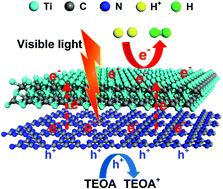2D/2D heterojunction of Ti3C2/g-C3N4 nanosheets for enhanced photocatalytic hydrogen evolution†
Abstract
Photocatalytic hydrogen evolution from water has received enormous attention due to its ability to address a number of global environmental and energy-related issues. Here, we synthesize 2D/2D Ti3C2/g-C3N4 composites by electrostatic self-assembly technique and demonstrate their use as photocatalysts for hydrogen evolution under visible light irradiation. The optimized Ti3C2/g-C3N4 composite exhibited a 10 times higher photocatalytic hydrogen evolution performance (72.3 μmol h−1 gcat−1) than that of pristine g-C3N4 (7.1 μmol h−1 gcat−1). Such enhanced photocatalytic performance was due to the formation of 2D/2D heterojunctions in the Ti3C2/g-C3N4 composites. The intimate contact between the monolayer Ti3C2 and g-C3N4 nanosheets promotes the separation of photogenerated charge carriers at the Ti3C2/g-C3N4 interface. Furthermore, the ultrahigh conductivity of Ti3C2 and the Schottky junction formed between g-C3N4/MXene interfaces facilitate the photoinduced electron transfer and suppress the recombination with photogenerated holes. This work demonstrates that the 2D/2D Ti3C2/g-C3N4 composites are promising photocatalysts thanks to the ultrathin MXenes as efficient co-catalysts for photocatalytic hydrogen production.

- This article is part of the themed collections: Nanoscale Most Popular Articles and National Nanotechnology Day


 Please wait while we load your content...
Please wait while we load your content...
